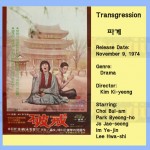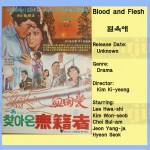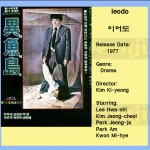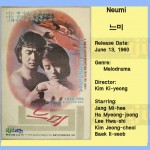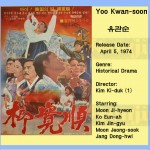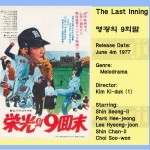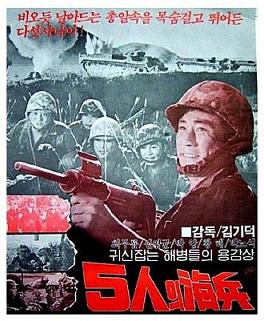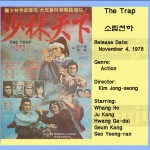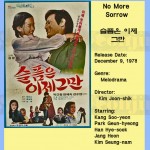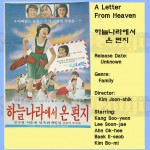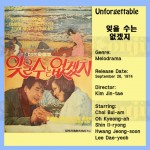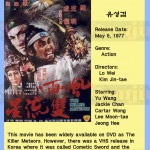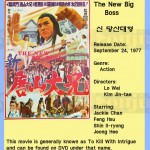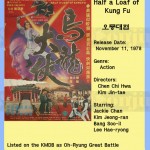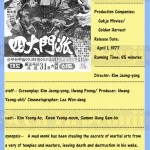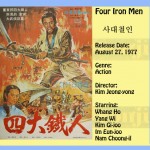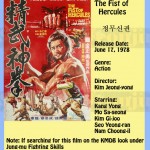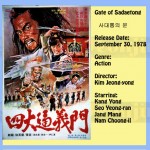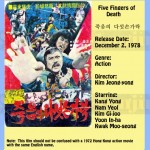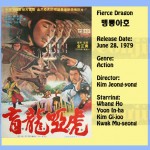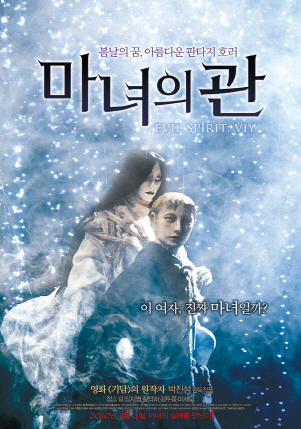 EVIL SPIRIT:VIY– Directed by Park Jin-seong. Starring Jeong Seung-gil, Im Ji-yeong, Hwang Taek-ha, Kim Doo-yong and Lee Se-rang. Running Time: 120 minutes. Debuted: 2008 Busan International Film Festival/ Theatrical Release Date: March 4, 2010.
EVIL SPIRIT:VIY– Directed by Park Jin-seong. Starring Jeong Seung-gil, Im Ji-yeong, Hwang Taek-ha, Kim Doo-yong and Lee Se-rang. Running Time: 120 minutes. Debuted: 2008 Busan International Film Festival/ Theatrical Release Date: March 4, 2010.
I watched EVIL SPIRIT: VIY last night with absolutely no expectations of it being particularly memorable and then spent half the night and the entire morning thinking about what I saw. This story is so complex and thought-provoking that I felt compelled to search out the source material and read it to gain insights into what I saw. Director Park Jin-seong does not create an easy film which you can relax while it spoonfeeds answers to you. Instead, you have to work to make sense of the images and actions. Even though I still do not have all the answers regarding what I saw, I want to say that this was one of the most ….. (hmm– I am struggling for words here.. I wanted to type ‘most satisfying’ but I am far from satisfied and I want to know more..ah! I’ve got it!) .. one of the meatiest movies I have seen in a long time. Before discussing it further I want to say two things. First, this review will have spoilers. It has to as I want to discuss the original short story and how it compares to the film. The second thing I need to say is that this movie will definitely not appeal to everyone. If you like your films to be easy to follow, clearly linear, and to make sense at first glance.. avoid this movie. If you want to see an experimental film that demands every ounce of your attention so you can piece it together, this is a film for you. Its style reminded me of the film WRITTEN, which I also loved and thought about for a long time afterwards.
EVIL SPIRIT: VIY is based on the short story THE VIY by Nikolai Gogol (1809-1852). In that story, a young seminary student is forced to read prayers over the body of a witch whom he, unknown to anyone else, had killed. The witch’s corpse becomes animated each night and attempts to harm him as he sits protected in a circle of protection he drewon the ground that keeps him hidden from evil. Her attacks become increasingly more powerful until, on the last night, she summons the VIY to find him and, when it does, she unleashes the force of hell against the seminarian.
The movie version directed by Mr. Park is divided into three chapters like an omnibus, but where the stories are more connected than many such films– and connected in unusual ways, sometimes even flowing into each other. Because the main characters are played by the same actors in all three sections, the intertwining of stories may be through one of the actors suddenly playing a character from a previous chapter.. and a chapters conclusion may suddenly occur in the course of another chapter’s story. In a lesser director’s hands, this could all come across as a confusing jumble, but director Park was able to create something quite fascinating.
I will begin by explaining the second chapter, first. This is not the be in keeping with the non-linear story-telling method employed by the screenplay. It is because the second story, entitled The Witch’s Coffin (which is also the title of this movie in Korean)most closely follows Gogol’s original work. The VIY, which is the King of the Gnomes in Russian folklore, makes no appearance however, despite his importance in the short story. But most of the other elements are there including the old witch who rides her victims to death as if they were horses, the flying coffin that the ghostly witch employs to try and drive the praying student out of his circle of protection, and witch herself, beautiful and terrifying at the same time. Also one of the two tales told by the Cossaks in the novel that proved the deceased young woman was known to be a witch is recreated for the movie… and in a very interesting way. You see, this chapter of the movie was set up as a stage play with all the exaggerated speeches and motions– and bare sets– that you might find in at an arthouse stageplay or in a college production of a drama. However, when the guard begins his flashback, the curtains behind the men open up and we are treated to a movie of his memories. The movie has an entirely different feel than the set it is screened on in that it is highly realistic and set in modern times as opposed to the highly stylized, uncertain timeperiod, of the rest of the second chapter. The part of this memory when the witch enters the house was one of the few times in this film where I jumped in surprise… for the most part, it is not that kind of horror movie. I was not exactly sure what she did to the mother and child until I had read the short story.. the movie is remarkable restrained here. Now, I did not mention the end of Gogol’s short story in this review (you can go and read it online like I did) and the chapter of the film does end either– instead, it switches to the characters and ending of the first chapter which, in retrospect.. and after reading the original story.. may be the ending of this chapter as well..
The first chapter, listed as The Strange Woman.. starts off with us watching a very creepy casting tape. This tape is the first few minutes of the movie opening credits and the way it is shot filled me with dread. While there is really nothing very scary about watching the woman dancing on the screen and coming gradually closer to the camera, the music, lighting and, most importantly, the way actress Im moves is both sets the viewer on edge with the expectation that something terrible is going to happen. Viewing the casting tapes are the director and his assistant who also play the seminary student threatened by the ghost and his friend, respectively. The director, simply called ‘P’ is thoroughly unlikeable. He is demanding, insulting and sullen. Never satisfied with anything, P decides to immerse himself in the role of the witch’s victim in order to fully understand the emotions of the film he is trying to make and to then be able to express his artistic vision on screen. You see, P is trying to film a modern-day version of Gogol’s story as a business allogory. However, his obsession with the plot, and with the lead actress who sometimes appear as if she might really be possessed by an evil spirit, blur together in his mind so that reality and fantasy become blurred– for both him and for the viewer. I often found myself questioning of something was really happening, if it was only his his mind, or if it was just a scene in the movie that he was making.
The final chapter, Curtain Call, follows most closely what we have come to expect horror movies to be. It reminds me of the old horror comics I would secretly buy as a kid.. Like House of Secrets or Tales of the Unexpected. These stories often had a twist that you could see coming from a mile off but were still somehow satisfying when they got to their ’surprise’ ending. In Curtain Call, the director P/seminary student now plays the role of a blind musician nicknamed Henri. Henri has a horrible job playing guitar in a Karaoke bar of questionable repute by night and tuning pianos with his roommate by day. His only joy in life is that he has been asked to direct and play the music for a puppet show/play that it being practiced by a small troupe set to tell Gogol’s story of VIY. (Puppet shows are also mentioned in Gogel’s story as a way the seminary makes money) Each night after work, Henri is met by the beautiful lady in black who operates the puppet of the witch.. a masterpiece in itself– and she leads him back to the hall where the rehearsals take place. There he is happy, with the performers going through a beautful, ritualized dance which mimics the movements we see of the witch attempting to reach the priest-in-training as we see in the second chapter. His performance is deeply appreciated by the rest of the crew who listen in delight to his playing and he feels happy and useful- finding joy in being with his newfound friends. However, his roommate begins to worry about him and follows Henri one night to the place the puppet show is practiced. There he spies a horror he never dreamt existed (and one of the most haunting images in the film) and takes steps to try and protect his friend from a fiend from the grave.
While there are some spoilers here, there is a lot I have not mentioned and your general enjoyment and surprise of this film will not be altered by reading this review. While it is classified as a horror film, it is not really what we have come to expect horror to be and except for three scenes– the audition tape in the first chapter, the flashback in the second chapter and what the roommate saw in the third–I did not generally feel scared while watching this film. I was more fascinated in figuring out what was going on. I have a feeling that this is a film that will only benefit from multiple viewings and I have every intention to see it again in the near future. It may not be to everyone’s taste, but it certainly was to mine. I am giving this film 9 out of 10 stars.
Back in July 2012, I wrote a review of Ahn Byeog-ki’s 2004 film, Bunshinsaba. The very first sentence of the review, for those of you who do not wish to click the link, was “If… I could choose any recent movie I wished to remake, it would be Bunshinsaba.” Earlier today, I was looking at the selections for the Pucheon International Fantastic Film Festival and saw that there will be a movie screened, directed by Ahn Byeong-ki, called Bunshinsaba 2. The movie, however, is not listed as a Korean-made film. Instead it was produced in China. A quick check of Ahn filmography revealed that he had directed another film in China a year early, that one entitled Bunshinsaba. Was it a remake of the Korean film that Ahn had made nearly a decade earlier? It turns out that the answer is ‘No.’ I tracked down the 2012 Bunshinsaba and have watched about half of it before writing this post.. I will be going back to viewing it soon. The new Bunshinsaba is completely unrelated. Instead of the story taking place in a high school with a tortured ghost possessing young women and causing them to set themselves on fire, the new movies have an entirely different premise. It is about a mother running from what may seems like an abusive relationship.. although at this point in the film I am beginning to question just how much I can believe of the main character’s memories and stories. She takes her young son with her to get him away from his father and they move into an old colonial style house owned by a friend deep in a forest. However, strange things begin happening almost immediately upon their arrival and her son forms a bizarre attachment to an ugly, scowling doll he finds in the garden. It soon becomes apparent to the woman that her son is not himself and the doll keeps turning up in the strangest places. At the point I am at in the film now, the doll is actually quite threatening… Of course, the movie is entirely in Chinese.. and has Chinese subtitles.. so I will not be writing a detailed review of a film I can’t understand. It is not a bad movie, but as yet has not really tread any new ground.

